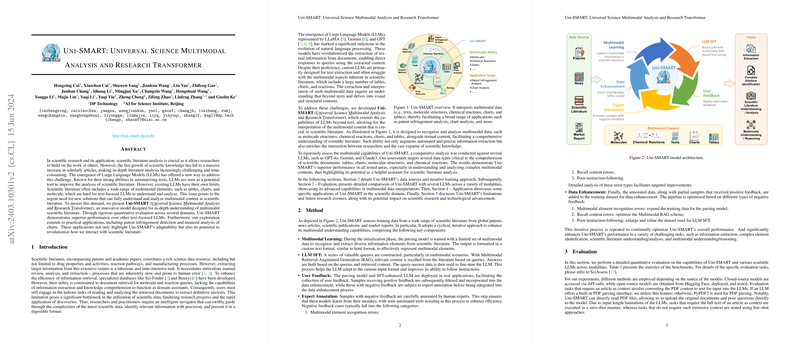An Evaluation of Uni-SMART: A Multimodal Analysis and Research Transformer
The paper on Uni-SMART presents a model focused on understanding multimodal scientific literature, addressing the complex challenges posed by various data types like tables, charts, molecular structures, and chemical reactions. Unlike traditional LLMs, which predominantly handle text, Uni-SMART aims to overcome the limitations encountered in interpreting multimodal content. This capability is especially relevant in scientific domains, where such multimodal elements are prevalent and critical in conveying complex scientific data and phenomena.
The authors propose Uni-SMART as a significant advancement in utilizing multimodal scientific literature. Through meticulous experimental design and evaluation, the paper substantiates Uni-SMART's superiority over existing LLMs such as GPT-4, GPT-3.5, and Gemini. The paper encompasses several domains, highlighting Uni-SMART's robust universal applicability across varied and challenging data. Noteworthy domains include alloy materials, drug discovery, organic materials, biology, and other areas reliant on the nuanced analysis of data formats like tables and charts.
Key Findings and Numerical Assessments
The evaluation results underscore Uni-SMART's adeptness across multimodal tasks:
- Table Data Understanding: Uni-SMART demonstrates high proficiency in tasks like "Electrolyte Table QA" with a remarkably high Value Recall score of 0.674, outperforming competitors across several table-based assessments.
- Chart Interpretation: Notable performance is observed in interpreting charts, with the model achieving an accuracy of 0.733 in the "Polymer ChartQA," showcasing a significant improvement over existing models.
- Molecular and Chemical Reaction Analysis: While excelling in molecule-related tasks, particularly "Markush to Molecule," Uni-SMART experiences some challenges in the "Affinity Data Extraction" task, slightly trailing behind GPT-3.5 in this specific aspect. However, its capability in chemical reaction analysis shows competence, reaching an accuracy of 0.445 in reaction mechanism tasks.
Methodology and Iterative Learning
Uni-SMART's development method involves an innovative cyclical, iterative training pipeline. This iterative approach incorporates multimodal learning, supervised fine-tuning with LLM techniques, user feedback integration, expert annotation, and data enhancement processes. Such methodology ensures continuous model improvement, maximizing the interpretive depth and accuracy across diverse modalities.
Practical Applications and Broader Implications
The application potential of Uni-SMART is notable. With scenarios in patent infringement analysis and temperature curve analysis within manufacturing processes, the model is positioned as a pivotal tool for accelerating scientific research processes and decision-making. By automating complex analysis involving simultaneous interpretation of multiple data forms, Uni-SMART offers efficiency gains and more reliable analysis outcomes, potentially transforming the way researchers interact with scientific literature.
Future Prospects
While Uni-SMART demonstrates pronounced advantages, further prospects include refining its understanding of highly complex content and ensuring reduction of generated hallucinations. Incorporating more specialized training data and advanced multimodal recognition strategies should further enhance the model's capabilities. Continuing to evolve Uni-SMART could reinforce its role as an indispensable multi-purpose tool that augments the acquisition and application of scientific knowledge while influencing technological innovation across domains.
In conclusion, Uni-SMART emerges as a significant model tailored for the precise demands of multimodal scientific literature understanding, marking a progressive step in AI's capacity to facilitate scientific inquiry and interpretations.
